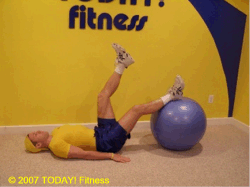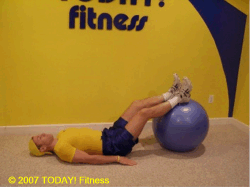|
Back to
Principles |
|
That's principles not
principals. Whether you are new to working
out, or you have been pumping iron for years, there are a
few principles that you should be aware of that often go
overlooked. A common mistake that can be made has to
do with getting comfortable with your exercise routine.
It's easy to feel good about
a workout that produces results... why shouldn't you?
However, to continue to obtain the maximum benefits from
your workouts, you're going to want to shake it up from time
to time. An important concept in fitness training
states that your body will adjust to the demands that you
place upon it. The SAID
principle (Specific Adaptations to
Imposed
Demands) basically states that once your body has adjusted
to the demands that you are putting on it, you will start to
see a decline in the rate of progress that you are making.
In order to continue to see the same rate of progress, you
will need to change (often increase) the demands that you
place on your body as you get used to a workout.
Following the principles of
Progression, it is
essential to continuously challenge yourself by changing
different factors in your routine as your body becomes
accustomed to it. These factors are termed the
FITT principle; Frequency,
Intensity, Time (duration), and Type
(mode). By changing these factors of your exercise
workout, you can alter the intensity of the
session. It is recommended that you only change one of
these factors at a time, while waiting several workouts
before incorporating additional changes.
Another way to change up your
workout that I have mentioned before has to do with changing
the order of the exercises in your routine. For
example, from time to time I will do the same routine that I
had been doing, but in reverse order. The idea behind
this is that your muscles are stronger at the beginning of
the workout and the first few exercises will get your
strongest effort. By changing the order of the
exercises, you will find that the easier exercises are
sometimes harder and vice versa due to the new placement in
the workout.
If you are going to continue
to put the time in to better yourself, then it is worthwhile
to learn more about how to best use that time.
Continue to challenge yourself and change up your workout.
You will get more benefits for your time and it helps to
keep you more motivated and interested.
"Complacency is devastating"
- Alex Boothe
|
|
Lady and the
Tramp |
|
Well, it's not
just an article for the ladies, but I kinda liked the Disney
spin for the article title. I picked up a mini-tramp (rebounder)
last year for about $30 and really didn't use it much until
a month ago. I promised my sister-in-law that I would
take her rebounding class and I found it both fun and
challenging. I would definitely recommend taking part
in one of these classes, or even picking a rebounder up for
use at home. There are a ton of exercises and routines
that can be accomplished on this simple piece of equipment,
but best of all... who doesn't like to bounce?
Rebounding
involves aerobic movements performed on a bouncing device
that looks like a small trampoline. It has you jumping up
and down for health and fitness. As an ideal jumping device,
the mini-trampoline or "rebounder," has a strong woven mat
attached by coiled steel springs to a circular steel frame.
The entire jumping surface of the mat is usually twenty-eight inches
in diameter, stands on six legs with spring coils of their
own, which are seven to nine inches high.
Adults start
with 5 minutes of rebounding and increase their time as
fitness improves. Seniors start with 2 minutes ten times per
day, with at least 30 minutes between sessions. It is
necessary for older people to start gradually in order to
give the connective tissue holding internal organs in place
time to strengthen.
By working against
constant gravitational pressure while bouncing, your resistance is subtle, but it builds
cellular strength. Rebounding's alternating weightlessness
and double gravity produce a pumping
action which pulls out waste products from the cells and
forces into them, oxygen and nutrition from the bloodstream.
The rebounding
motion stimulates all internal organs, moves the
cerebral-spinal fluid, aqueous fluid within the eyes (many
people claim improved eyesight), and does wonders for the
intestines. All cells in the body become stronger in
response to the increased G force during rebounding, and
this cellular exercise results in the self-propelled immune
cells being up to 5 times more active thereby
strengthening the immune system.
Rebounding is also a lymphatic
exercise. The lymphatic system is the metabolic
garbage can of the body. It rids you of toxins such as dead
and cancerous cells, nitrogenous wastes, fat, infectious
viruses, heavy metals, and other assorted junk cast off by
the cells. The movement performed in rebounding provides the
stimulus for a free-flowing system that drains away these
potential poisons. Vigorous exercise such as
rebounding is reported to increase lymph flow by 15 to 30
times.
Jumping on the
mini-trampoline is remarkably un-strenuous on the Joints.
Your movements are perfectly safe, and they make
the effect of gravity beneficial. Rebounding has the same
effect on your body as jumping rope, but without any jarring
effect to the ankles, knees, and lower back that comes from
hitting the ground. Better than rope jumping, however, the
lymphatic channels get put under hydraulic pressure to move
fluids containing waste products of metabolism around and
out of the body.
Bouncing on a rebounder is an
excellent method of reducing stress. Jumping for
health and fitness not only stabilizes the nervous system
during the exercise period, but continues to help maintain
equilibrium after one steps off the device. The result is
increased resistance to environmental, physical, emotional,
and mental stress.
My recommendation? Hop
to it if you get the chance!
|
|
 |
|
|
Elite
Bodyweight Exercise of the Month! |
|
Swiss Ball Hip Raise & Curl

Summary:
Many people look at the swiss ball (resistance ball, stability
ball) and think that it is only for those novice, easy
exercises. If you want a great and challenging butt and
hamstring exercise, try this one! This is a 4 count
exercise that combines a hip raise (for your butt) with the
leg curl for your hamstrings. Start with two legs and
work your way up to 1 leg at a time. Machine hamstring
curls got nothing on this exercise!
Target:
legs and butt (hamstrings, gluteals)
Count:
4 count
Description:
Whether using one leg or two, start lying on your back with
your feet and ankles on the ball. Raise your hips up so
that your body makes a straight line from your shoulders to
your knees. Maintaining this straight line, curl your
ankles to your butt as far as you can go. Straighten
your legs again, then lower your butt to the floor again.
Repeat for the desired number of reps.

|
|
Surviving the
Office Lunch |
In the world of business, lunch
is not simply afternoon nourishment. Dining out with a
client can be the key to closing the deal and nabbing the
next big account. Breaking bread with your manager may
help you win that primo assignment that puts your career on
the fast track. And chowing with co-workers at a local
restaurant could be the key to helping you survive office
politics. Sound like a recipe for a potbelly? It
doesn't have to be. With a little proactive planning,
you can get through it.
- Always grab breakfast -
Skipping your morning meal or mid-morning snack may seem
like a way to offset extra calories at lunch, but in
reality, it just leave you so hungry that you're bound to
overeat once you get a plate of food in front of you.
Instead, opt for high-protein or high-fiber foods that
will stick with you as long as possible. Think
things like eggs, peanut butter, oatmeal, and fresh
berries.
- Strategize your meal -
Ordering the "wrong" food at lunch is usually the result
of being rushed and distracted. It can be hard to
concentrate on a menu when you're trying to conduct
business. The solution? Before going to lunch
with a client or your boss, check out the restaurant's
offerings online and make some decisions before you go.
(If the menu isn't available online, most places will be
happy to fax one over.)
- Start off with something
bulky - Green salads or vegetable soups add bulk to your
stomach, filling you up with a minimum of calories - and
helping you eat less of your main entree' before you feel
stuffed.
- Avoid liquid calories -
Your brain has a harder time knowing how many calories
you've taken in when you drink something compared to when
you eat. That means a zero-calorie cup of water is
just the same to your gut as a cup of pure sugar water.
So stick with diet soda, unsweetened tea, and water.
Don't forget to skip the sugar and reach for a low-cal
sweetener when it's time for that post-lunch cup of
coffee.
The Bottom Line:
Remember, the office lunch may be all about business, but
it's really nobody's business what you eat. If you
don't want a roll, just pass the bread basket along without
comment. Besides, if you stick to talking business,
you'll wind up with plenty of bread in the end.
D. Milton
Stokes, R.D. - Men's Fitness
|
|
It's
Go Time! |
|
You
haven't failed until you quit trying! One of the
first mistakes people make when they fall short of their
goal is to think, "That's it, I've blown it. I'll
never make this work. Maybe I'm just destined to be a
couch potato."
Don't
believe it. A one-time slip doesn't mean you're a
failure. It doesn't mean you're fated to be sedentary.
That's the all-or-nothing trap, and plenty of people with
the best intentions have fallen into it. People
mistakenly think, "Either I stick to my plan and meet my
goal, or I'm a failure."
The fact
is, all-or-nothing thinking is taking the easy way out.
It's a fancy way of quitting. Maybe you've missed a
day or two of activity. Maybe you've blown a whole
week. Maybe you've been sick, injured yourself, or run
into some family trouble, and you've been out of commission
for a month or more. The important point is to
understand it for what it is: a lapse. Sure
you've fallen a step behind, but your hard work is not lost.
Remind yourself of all you've learned and how far you've
come since you started. With a little effort you can
take two steps forward and keep up the progress you've been
making. One thing you don't want to do is give up!
Set new goals, avoid negative messages, and focus on your
strengths.
Since the
fall temperatures are not as hot as the summer, and not yet
cold, it makes for a perfect time to engage in some good
outdoor exercise before winter hits us again. If
you're like me, you have about 2 months left for walking,
jogging, cycling, kayaking or other outdoor exercise before
it gets too cold for comfort. Personally, I typically
take my workouts indoors around Halloween. Many people
have been promising themselves that NEXT summer they are
going to be in better shape for beach and pool season.
This doesn't happen over night so stop making excuses to put
it off and start TODAY!
For prior issues of this
newsletter go to
www.todayfitness.net/news.
Good Luck!
Pete
Mazzeo, CPT
pmazzeo@todayfitness.net
"Mediocrity is within anyone's reach" | |